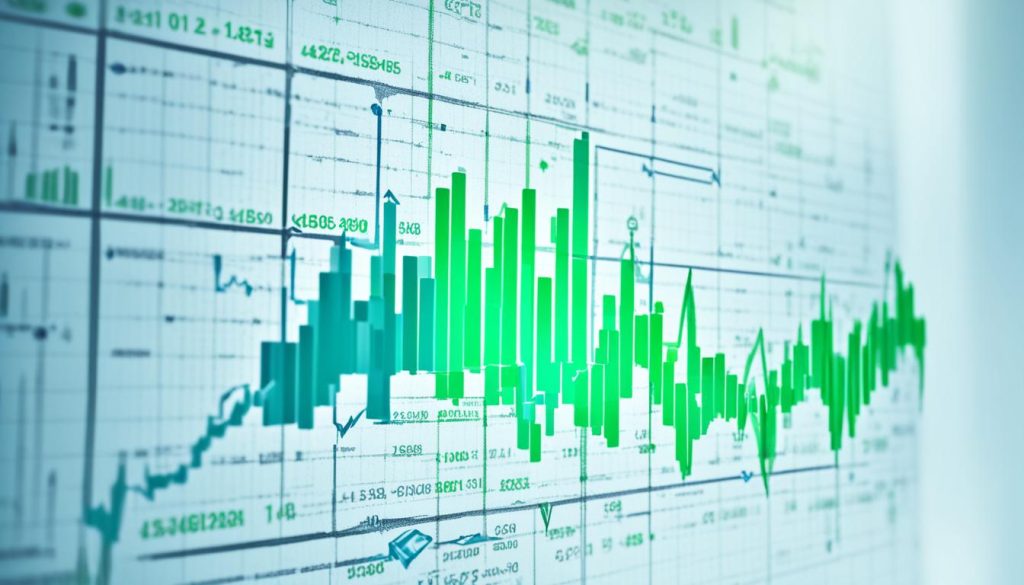Market capitalisation, also known as market cap, is a fundamental concept in finance that determines the total dollar market value of a company’s outstanding shares of stock. It is a measure used by investors to gauge the size and value of a company, providing valuable insights into its financial performance and market standing.
Instead of relying solely on sales or total asset value, market cap takes into account the price of the company’s shares and the number of shares available in the market. This figure helps investors assess the size of a company and compare it to other companies within the same industry or across different sectors.
By understanding a company’s market cap, investors can make better-informed investment decisions. Market cap can indicate the stability, growth potential, and risk level associated with a particular company. It is a valuable metric for evaluating investment opportunities and building a diversified portfolio.
In this article, we will explain in detail how market cap is calculated, the different categories of market cap, and its significance in investment decisions. We will also address misconceptions about market cap and highlight the factors that can alter a company’s market cap.
Stay tuned for a comprehensive exploration of market capitalisation and its role in the world of finance.
What Does Market Cap Mean?
Market capitalisation, often referred to as market cap, is a key financial metric used to measure the total value of a company’s outstanding shares of stock. It is calculated by multiplying the current market price of a single share by the total number of outstanding shares.
Market cap provides investors with an indication of a company’s size in the market and is used to determine its overall worth. Companies with a higher market cap are generally considered to be more stable and less risky investments compared to those with lower market caps.
Market cap is also used to categorise companies into different classes such as large-cap, mid-cap, and small-cap. Large-cap companies typically have a market cap of over £5 billion, mid-cap companies have a market cap between £1 billion and £5 billion, and small-cap companies have a market cap below £1 billion.
Overall, market cap is a useful tool for investors to evaluate a company’s value and make informed decisions about their investment portfolio.
Understanding Market Cap Calculation
In order to understand the market capitalization or market cap of a company, it is essential to know how to calculate it accurately. Market cap is calculated by multiplying the number of outstanding shares by the current market value of one share. This calculation helps investors estimate a company’s value and compare it to other companies of various sizes.
The formula for market capitalization is:
Market Cap = Current Share Price * Total Number of Shares Outstanding
By applying this formula, investors can determine the total market value of a company based on its share price and outstanding shares. This metric allows for a meaningful comparison of companies in terms of their market size and value.
For example, let’s consider a hypothetical company with a share price of £50 and 1 million outstanding shares. The market cap would be calculated as follows:
Market Cap = £50 * 1,000,000 = £50,000,000
This means that the market cap of the company is £50 million.
Market cap calculations are crucial for investors as they provide insights into the relative size and value of a company. Comparing market caps allows investors to assess a company’s standing in the market and make informed investment decisions.
Using a Market Cap Calculator
While the market cap formula is simple, it can be time-consuming to manually calculate for multiple companies. To simplify the process, investors can utilize market cap calculators available online. These calculators provide a user-friendly interface where investors can input the share price and number of outstanding shares, and the calculator will automatically compute the market cap.
Utilizing a market cap calculator saves time and ensures accurate calculations, allowing investors to focus on analyzing and comparing companies based on their market cap.

Market Cap Categories: Large-Cap, Mid-Cap, and Small-Cap
Companies are often categorized based on their market capitalization. Market capitalization, or market cap, is a key measure of a company’s size and value in the stock market. It is calculated by multiplying the company’s share price by the total number of outstanding shares.
Market cap is important for investors as it provides insights into a company’s positioning and potential. Let’s explore the different market cap categories:
Large-Cap Companies
Large-cap companies have a market capitalization of $10 billion or more. These companies represent major players in well-established industries. With their substantial market value, they often enjoy stability and have a strong market presence. Examples of large-cap companies include Apple Inc., Microsoft Corporation, and Amazon.com Inc.
Mid-Cap Companies
Mid-cap companies have a market capitalization between $2 billion and $10 billion. They operate in industries expected to experience rapid growth, offering investors the potential for higher returns. These companies are often characterized by a combination of stability and growth opportunities. Examples of mid-cap companies include Chipotle Mexican Grill Inc., Advanced Micro Devices Inc., and Square Inc.
Small-Cap Companies
Small-cap companies have a market capitalization between $250 million and $2 billion. They are typically found in niche markets and new industries. While small-cap companies may carry higher risk due to their size and relative lack of resources, they can also offer significant growth opportunities for investors. Examples of small-cap companies include Elanco Animal Health Inc., The Simply Good Foods Company, and Bed Bath & Beyond Inc.
Understanding the market cap categories is crucial for investors as it helps them assess the size, potential, and risk associated with different companies. It allows investors to build a diversified portfolio by considering companies from various market cap segments.
| Market Cap Category | Market Capitalization | Examples |
|---|---|---|
| Large-Cap | Over $10 billion | Apple Inc., Microsoft Corporation, Amazon.com Inc. |
| Mid-Cap | $2 billion – $10 billion | Chipotle Mexican Grill Inc., Advanced Micro Devices Inc., Square Inc. |
| Small-Cap | $250 million – $2 billion | Elanco Animal Health Inc., The Simply Good Foods Company, Bed Bath & Beyond Inc. |
Market Cap and Digital Currency
Market cap is also relevant in the world of digital currency. Analysts use diluted market cap to understand potential changes to a security, token, or coin’s price. Calculating the market cap for digital currencies involves multiplying the current share price by the total number of shares authorized. This helps investors assess the value and potential of different cryptocurrencies.
| Cryptocurrency | Current Share Price | Total Number of Shares Authorized | Market Cap |
|---|---|---|---|
| Bitcoin | $44,278 | 18.8 million | $832.3 billion |
| Ethereum | $3,235 | 116.5 million | $377.5 billion |
| Ripple (XRP) | $1.14 | 46.7 billion | $53.2 billion |
As seen in the table above, Bitcoin has the largest market cap among cryptocurrencies, followed by Ethereum and Ripple (XRP). This data provides insights into the size and value of these digital assets, allowing investors to make informed decisions.

Market capitalization plays a crucial role in understanding the significance of different digital currencies. It helps investors gauge the overall value and potential growth of the cryptocurrency market. By analyzing market cap, investors can identify trends, assess the stability of different digital assets, and make informed investment decisions.
Misconceptions About Market Caps
Despite its prominence in the financial world, market capitalization can sometimes be misunderstood. Let’s address a few common misconceptions about market caps and clarify their true meaning.
1. Market Cap vs Market Value: One misconception is that market capitalization represents the equity value or worth of a company. While it is an indicator of a company’s size and relative value in the market, it does not reflect the true equity value. To determine a company’s equity value, a comprehensive analysis of its fundamentals is necessary.
2. Market Cap vs Enterprise Value: Another misconception is that market capitalization determines the cost of acquiring a company in a merger or acquisition. In reality, enterprise value, which includes factors such as debt and cash, provides a more accurate measure of a company’s acquisition cost. Market cap alone does not reveal the full picture when evaluating acquisition opportunities.
Understanding these distinctions between market cap, market value, and enterprise value is crucial for investors when assessing companies and making informed investment decisions.

Revisiting the Definitions
Let’s briefly recap the definitions:
- Market capitalization: It represents the total market value of a company’s outstanding shares of stock. It is calculated by multiplying the number of outstanding shares by the current market price per share.
- Equity value: It reflects the true worth of a company’s equity, determined by analyzing its financial fundamentals.
- Enterprise value: It takes into account a company’s market capitalization, debt, and cash to provide a more comprehensive measure of its acquisition cost.
By comprehending these concepts, investors can gain a clearer understanding of a company’s value, potential risks, and strategic investment opportunities.
What Factors Alter a Company’s Market Cap?
When it comes to a company’s market cap, several factors can significantly impact its value and position in the market. Understanding these factors is crucial for investors who want to make informed decisions and assess the significance of stock cap and market cap importance.
One of the key factors that can alter a company’s market cap is the price of its stock. Significant changes in stock prices can lead to fluctuations in market cap, as the market value of a company’s outstanding shares increases or decreases. When a stock price rises, the market cap tends to increase, indicating a higher perceived value. Conversely, a decline in stock price can result in a lower market cap, suggesting a decrease in value.
Another factor that can impact market cap is the issuance or repurchase of shares by the company. When a company issues new shares, it can lead to an increase in the total number of outstanding shares, thereby affecting market cap. On the other hand, if a company repurchases its own shares, it reduces the number of outstanding shares, potentially influencing market cap as well.
Investors should also consider the exercise of warrants by shareholders. When warrants are exercised, new shares are issued, which can affect the number of shares in the market and subsequently impact market cap. The exercise of warrants can result in dilution of existing shares and alter the ownership structure of the company.
These factors collectively highlight the dynamic nature of market cap and the constant changes that can occur in a company’s perceived value. By closely monitoring stock prices, share issuance, repurchases, and warrant exercises, investors can gain a better understanding of a company’s market cap and its implications.

Ultimately, the market cap of a company serves as an important metric for investors to evaluate the size and value of a company. It provides valuable insights into a company’s financial performance, stability, and growth potential. By considering these factors and understanding the importance of market cap, investors can make well-informed investment decisions and build a diversified portfolio.
The Importance of Market Cap in Investment Decisions
When it comes to making investment decisions, market cap plays a crucial role in providing investors with valuable insights. Market cap, short for market capitalization, serves as a baseline for analysis and comparison, allowing investors to evaluate a company’s value relative to its peers and gain a deeper understanding of its financial performance.
One of the key reasons why market cap is important is that it helps investors assess a company’s size and significance in the market. By knowing a company’s market cap, investors can determine whether it is a large-cap, mid-cap, or small-cap stock. This categorization is essential as different market cap categories represent companies with varying growth expectations, risk levels, and market positions.
Market Cap Categories
| Market Cap Category | Market Capitalization Range | Typical Characteristics |
|---|---|---|
| Large-Cap | £10 billion or more | Major players in well-established industries |
| Mid-Cap | Between £2 billion and £10 billion | Operating in industries expected to experience rapid growth |
| Small-Cap | Between £250 million and £2 billion | Serving niche markets and new industries |
By understanding a company’s market cap category, investors can align their investment strategies with their risk tolerance and growth expectations. Large-cap stocks tend to be more stable, while small-cap stocks can offer greater growth potential but also higher volatility.
In addition to categorizing companies, market cap is often used in conjunction with other financial metrics to gain deeper insights into investment opportunities. By comparing a company’s market cap to its revenue, earnings, or other key financial indicators, investors can assess whether a stock is overvalued or undervalued in relation to its peers.
Furthermore, market cap helps investors identify trends and spot investment opportunities in various sectors. For example, if small-cap stocks in a particular industry are experiencing significant growth, it may indicate a growing market segment with promising investment potential.
Importance of Market Cap in Diversification
Diversification is a fundamental principle of investing, aimed at reducing risk by spreading investments across different asset classes, industries, and market caps. Market cap serves as a vital factor in diversification, as it allows investors to balance their portfolios and avoid overexposure to specific market segments.
Whether an investor aims to focus on large-cap stocks for stability or seek out emerging opportunities in small-cap stocks, understanding market cap and its significance is essential for making informed investment decisions and building a well-rounded portfolio.
Conclusion
Market capitalization, or market cap, plays a crucial role in helping investors evaluate the size and value of a company. By analyzing a company’s market cap, investors gain insights into its stability, growth potential, and risk level. Understanding the significance of market cap is vital for making informed investment decisions and building a diversified portfolio.
Market cap provides a baseline for analysis and comparison, allowing investors to assess a company’s value relative to its peers. This metric is often used alongside other financial indicators to obtain a comprehensive understanding of investment opportunities. Whether a company is categorized as a large-cap, mid-cap, or small-cap, its market cap serves as a key reference point for investors seeking to evaluate its financial performance.
Investors should recognize that market cap does not measure the equity value of a company; a thorough analysis of a company’s fundamentals is necessary for that purpose. Additionally, market cap alone cannot determine the acquisition cost in a merger transaction; enterprise value, which factors in debt and other financial obligations, is a more accurate measure in such cases.
In conclusion, market cap is a powerful tool for investors that offers valuable insights into the size, value, and potential of a company. By understanding the significance of market cap and considering it in conjunction with other financial metrics, investors can make informed decisions and navigate the complexities of the stock market.





